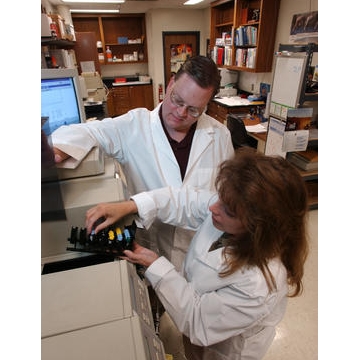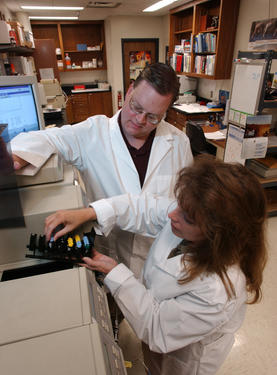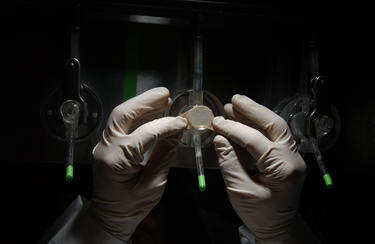UNM Researchers Find Microplastics in Canine and Human Testicular Tissue

Apply Frequently: Sunscreen Research at UNM
Exposure to ultraviolet (UV) rays is a serious concern for anyone living in the Land of Enchantment. With more than 300 days of sunshine, a high altitude, and a relatively southern latitude, New Mexicans are exposed to more intense UV rays than residents of most other states. Combined with the outdoor lifestyle that many New Mexicans enjoy, the risk of developing nonmelanoma skin cancer is significantly increased.
According to Donald Godwin, PhD, Associate Professor for Pharmaceutics at the UNM College of Pharmacy, this type of skin cancer, although usually not fatal, affects more than one million Americans each year, and New Mexicans are hit particularly hard. In fact, New Mexico has the highest per capita rate of nonmelanoma skin cancer in the United States.
"UV radiation is the primary cause of skin cancer," said Godwin. The good news is there are ways for people to protect themselves from sun exposure. One of the most common is the use of sunscreens.
"Sunscreens work. They block, absorb and scatter UV radiation," said Godwin. "The problem is that they are absorbed by the skin relatively quickly and require frequent reapplication."
Godwin said that as early as 20 minutes after application, typical sunscreens may begin to penetrate through the skin and lose their effectiveness. The duration of effectiveness is influenced by many factors, including perspiration, thickness of application and exposure to water. "That's why the bottles always say 'reapply frequently'; unfortunately most people don't do this."
To improve the staying power of sunscreens, Godwin teamed with fellow UNM researcher Linda Felton, PhD, Associate Professor for Pharmaceutics, to develop a process that would minimize the skin's absorption of sunscreen. In 2002, Godwin and Felton were successful.
"We looked at cyclodextrins, cyclic sugar molecules derived from starch, that have been used in the pharmaceutical industry to alter the solubility and stability of various drugs," explained Felton. "Cyclodextrins have a unique bucket like structure that creates a reservoir on the skin's surface, allowing the sunscreen to absorb more slowly," she said.
Their initial research study, published in Drug Development and Industrial Pharmacy in 2002, showed a significant reduction in the skin's absorption of oxybenzone, one of the chemicals most commonly used in sunscreens. In a follow-up study, Felton and Godwin looked further at the effectiveness of a sunscreen containing cyclodextrins and found a reduction in sunburned cells and skin swelling following exposure to UV rays. The results of this study have recently been accepted for publication.
"We hope that by using the cyclodextrins as additives in existing sunscreens, we can extend the amount of time the sunscreen remains on the skin and reduce the need for reapplication," said Godwin.
Felton and Godwin are also working with Graham Timmins, PhD, Assistant Professor of Medicinal Chemistry and Toxicology in the UNM College of Pharmacy, on a process for modifying the cyclodextrins so that they will actually attach to the skin and become waterproof and thus will not be compromised by swimming or perspiring. They have already filed a provisional patent on this technology.
Since both Godwin and Felton believe that many people become sunburned and increase their risk of skin cancer because they fail to reapply their sunscreen as often as necessary, they feel their research will make a real difference for New Mexicans.

